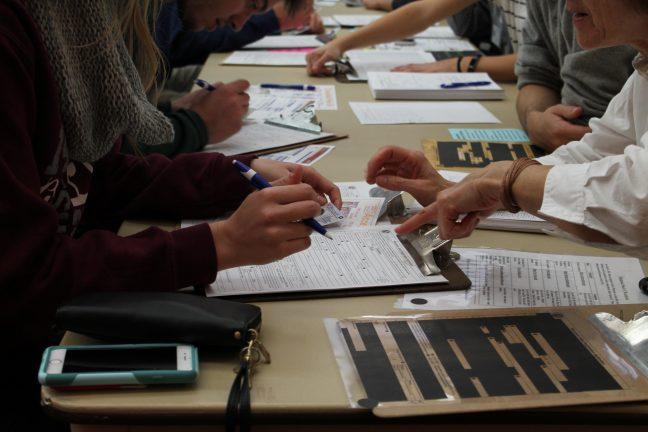Only two days before the Wisconsin ballot recount is scheduled to begin, former Green Party presidential candidate Jill Stein sued the Wisconsin Elections Commission to compel districts to hand count ballots.
Stein filed a lawsuit against the WEC Friday afternoon and met the 4:30 p.m. Tuesday deadline to pay $3.5 million to carry out the recount.
But a Dane County judge concluded Tuesday districts across the state may choose to electronically recount ballots, though she acknowledged hand counting may be more accurate.
Judge Valerie Bailey-Rihn said in a hearing at the Dane County Courthouse the prosecution did not provide clear evidence of a mistake in ballot results that would force counties to recount ballots by hand.
Stein’s lawyers raised concerns about outside cyber attacks and potential errors in how electronic ballot readers counted the results in the state. They called in three experts on computer security, statistics and election security to testify whether or not a hand count is necessary to ensure the results of the presidential election were accurate.
Every vote counts
Professor Philip Stark, an expert in statistics from the University of California-Berkeley, said a difference of 11,000 votes for President-elect Donald Trump and former Democratic candidate Hillary Clinton, about 0.38 percent of votes cast in Wisconsin, could make a difference in who won the state.
Clinton joined the recount effort Tuesday, according to court documents.
Even if the tabulation was 99 percent accurate, the error could be statistically significant, Stark said.
However, the defense pointed to a state statute as its main opposition to a mandatory statewide hand count. WEC Administrator Michael Haas, a witness for the defense, said Wisconsin statute 5.901 gives the power to make the decision of counting the ballots by hand or electronically to local officials, the board of canvassers, based on the county clerk’s recommendation.
The process
A two-pronged criteria outlined in Wisconsin statute must be met in order to compel local officials to count ballots by hand.
First, the prosecution has to provide evidence there was an error in how the votes were counted. Second, it must prove a more accurate hand count would affect the ultimate outcome of the election.
Bailey-Rihn said while the prosecution possibly met the second requirement based on expert testimony it wasn’t enough that they thought there was a chance the machines could have been hacked or faulty. She said there wasn’t enough of a link between Wisconsin election results and hacking from foreign countries.
“All the experts indicated that yes, there are these potential issues, and I understand the problem,” Bailey-Rihn said. “The problem is you don’t know there’s going to be an issue until you do [the recount.] But under the statute, I can’t speculate.”
The judge would have to find some sort of defect, mistake or irregularity in the electronic results by clear and convincing evidence, she said.
Bailey-Rihn said the canvassing boards must be allowed to make the decision by default, though she encouraged them to hand count the ballots rather than use the machines.
“I may disagree with it,” she said. “I may see that the hand ballots is the best way. I think we would all agree with that. But I can’t put myself in their position. I understand it is extremely important to the people of the state of Wisconsin. I understand that it is extremely important to the nation. But I must follow the law.”
Voting in Wisconsin
Haas said 19 of Wisconsin’s 72 counties plan to use automatic tabulating equipment to count the ballots. He said the ballots will still be viewed by the talliers, members of the public and representatives from political parties, but they will be fed into the machines.
Votes are cast via one of three methods, according to court documents: optical scan machine, touch-screen machine and hand counting.
Stark said machines can fail to read voter intent — such as writing an “x” rather than filling in a circle — or suffer from mechanical issues, such as not counting ballots stuck together, re-scanning ballots or not reading various types of ink.
Haas outlined the steps the WEC takes in working with municipalities to ensure accuracy, including extensively field testing voting machines, sealing off the machines from unauthorized people before the elections and conducting an audit to check the machines’ accuracy after the election.
Hand vs. electronic vote counting
John Holderman, a University of Michigan professor of computer science and engineering, said tamper-evident seals are not effective against cyber attacks and are easily unscrewed. Upon cross-examination, however, Holderman said he was not familiar with the exact seal technology.
Professor Ronald Rivest from the Massachusetts Institute of Technology, specializing in election security, computer science and cryptography, explained how checking a paper ballot prevents undetected software changes from generating undetectable changes in the election outcome.
Rivest said he favors hand counting ballots, calling it the “gold standard” for accuracy.
“[Hand counting] reflects the will of the voters without the potential corruption of any errors in the programming of the machines that are doing the scanning,” Rivest said.
Stark said though there were suspicious results found in terms of vote totals, it did not conclusively mean anything malicious happened. He said the amount of error that could cause the difference is very small and could be attributed to normal malfunctions. The only way to be certain the same mistakes wouldn’t be repeated would be by hand counting.
Despite Dane County being the second largest voting county in the state, local officials elected to count the ballots by hand.
“The right to vote is a cornerstone of our democracy,” Bailey-Rihn said. “A recount isn’t a threat. Instead, it should be an affirmation of the democratic process.”
Similar efforts are underway in Michigan and Pennsylvania. The Wisconsin recount will begin 9 a.m. Thursday.


